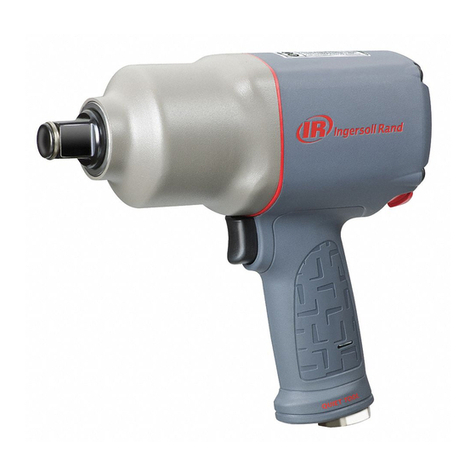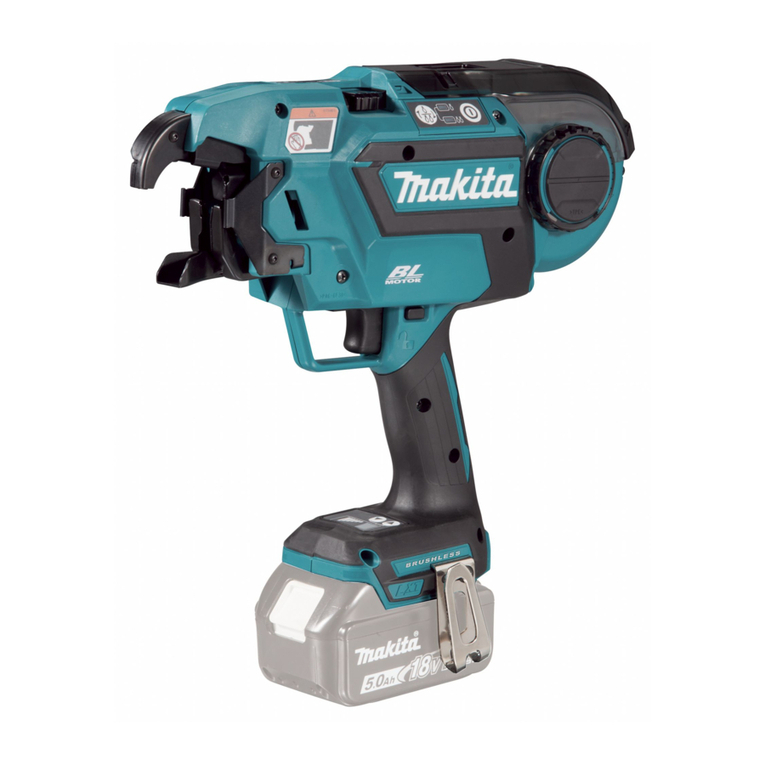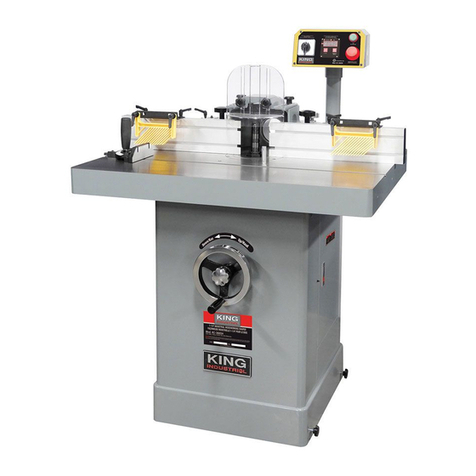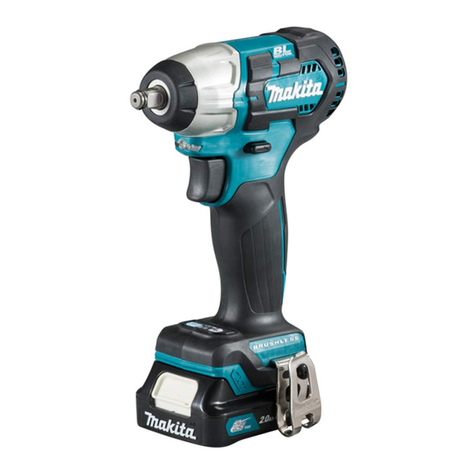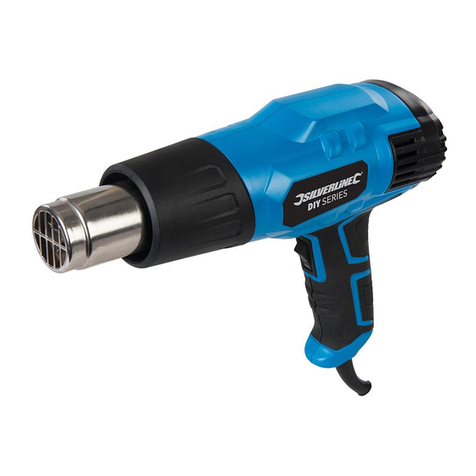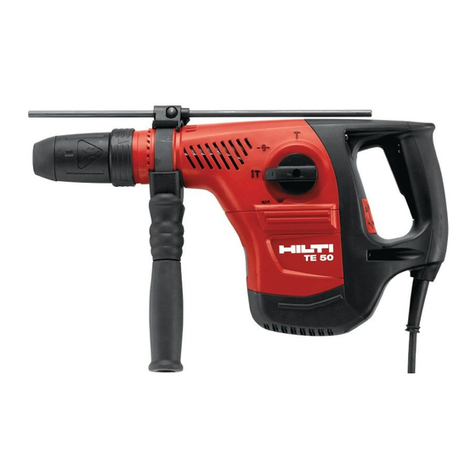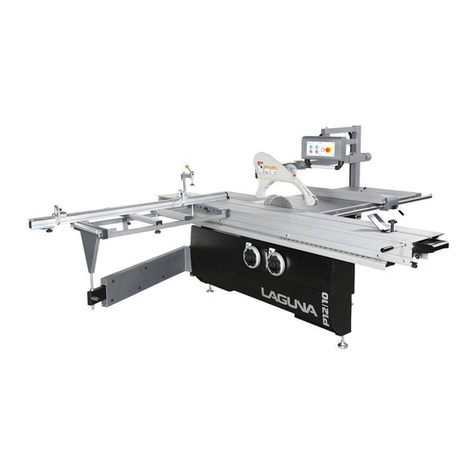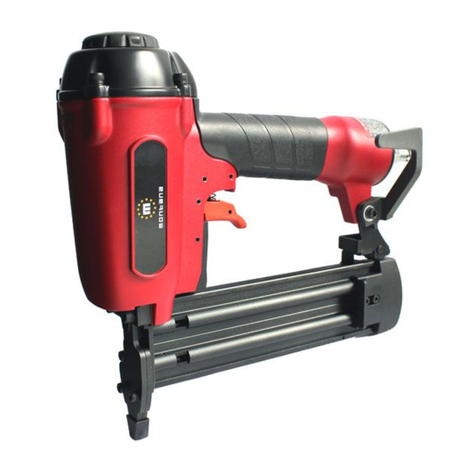Cutler-Hammer AIL 124 manual

AI L
TYPI
12,4
POWER
...
OSCILLATOR
I
J
u'';''
l.9.,6·0·
Airborne
Instruments
Laboratory

FIGURE
'-I.
TYPE
124
POWER
OSCILLATOR,
FRONT
VIEW

TABLE OF CONTENTS
Page
.....-...-..
Section
I--General
Description
1-1
Section
3--Inatallatlon
Section
2--Theory
of
Operation
Section
4--0peration
1 .
General
2.
Inspection
3·
Installation
4.
Load
1-1
1-1
1-2
1-2
2-1
2-1
2-1
2-5
2-6
2-8
2-9
3-1
3-1
3-1
3-1
3-2
4-1
4-1
4-1
4-2
4-2
4-3
4-5
General
Description
Characteristics
Tube Complement
Ge
ne
r-aI
Radio-Frequency
Oscillator
Audio-Frequency
Oscillator
Modulation
High-Voltage
Power
Supply
Low-Voltage
Power
Supply
Pre-Operation
Procedure
Starting
Equipment
Oscillator
Adjustment
Frequency-Range
Settings
for
RF
Oscillator
Changing
Ranges
Modulation
Adjustments
4.
1 ,
2.
3.
4.
1.
2.
3.
5.
6.
1.
2.
3.
4.
5.
6.
1

Section
5--Ma1ntenance
and
Trouble-Shooting
1.
2.
3.
4.
5.
6.
7.
8.
General
Replacement
of
Oscillator
Tube
Repair
Removal
Depth
Setting
of
Feedback
Assembly
Counter
Calibration
Trouble
Analysis
of
Cavity
voltage
Measurements
Resistance
Measuraments
Table
of
Replaceable
Parts
11
Page
--..-.
5-1
5-1
5-1
5-2
5-2
5-2
5-4
5-5
5-8
5-9
5-10

Figure
Frontis-
piece
1-1
1-2
2-1
2-2
2-3
2-4
2-5
2-6
2-7
5-1
LIST
OF
ILLUSTRATIONS
Type
124
Power
Oscillator
Type
l2~
Power
Oac111ator
J
Front
View
Type
124 Power
Oscillator)
Top
and
Bottom
Views
Type
12
l•
Power
Oscillator,
Schematic
Diagram
Tuning
Curve
for
Low-Low-Frequency
Range
Tuning
Curve
ror
Low-Frequency
Range
Tuning
Curve
for
High-Frequency
Range
Type
124
Power
Oscillator
J
Rear
View
Pulsing
Characteristic
of
Type
124
Power
Oscillator
Mini.mum. Pul
ae
Length
Obtainable
with
Modified
Circuit
Type
124
Cavity
Parts
Identification
111
.

,.\
~,i~,
;,1
.,
....
.
.•..
,.
"':'"
~'
-
1.·
...
s :
.....
..
:=.
~.~
;:::~#::·::i>;:·:····:'
& . "".
Y?~~:
·;~·a·_~
.....
':,,"
....
::.,';"
-=--i:~·':.~.~:···~·~··
c
.::-.:.
...•.
-
~~,~
~
"'0
FRONTISP\ECE.
,.'(PE
\24
POWER
OSCILLATOR
1
1
1
1
1
1
1
1
1
1
1
1
1
1
1
1
1
1
1
1
1
1
1
1
1
1
1
1
1
1
1
1
1
1
1
1
1
1
1
1
1
1
1
1
1
1
1
1
1
1
1
1
1
1
1
1
1
1
1
1
1
1
1
1
1
1
1
1
1
1
1
1
1
1
1
1
1
1
1
1
1
1
1
1
1
1
1
1
-1

SECTION
1
GENE:RAL
DESCRIPTION
1.
GENERAL
The
Type
124 Power
Oscillator
(Figures
1-1
and
1~2)
provides
sIgnals
at
rrequenc1ea
rrom
200
to
2500
Me
1n
three
ranges;
it
delivers
continuous-wave,
sine-wave
modulated,
e·quare-wave
modulated,
or
(u.nder
certa.1n
conditions)
pulae-
modulated
signals.
An
internal
audio
oscillator
permits
sine-
wave
modulation
of
the
RF
oscillator
at
either
400
cps
or
lOOO,cpSj
an
external
oscillator
can
be
used
to
drive
the
modulator
at
frequencies
trom
20.CpB
to
150
kc.
External
sources
or
square
waves
or
pulses
can
also
be
used
to
modulate
the
oscillator.
Pure
pulse
output
Is
not
obtainable
under
all
eondd
t
Lons
,
This
limitation
1s
described
more
fully
in
Sec-
tion
2,
paragraph
4d.
2.
DESCRIPTION
The
Type
124
Power
Oscillator
16
designed
for
either
bench-top
or
standard
relay-rack
mounting
(for
rack
.mounting,
the
two
side
handleB
must
be
removed)n
It
is
housed
in
a
single
chassis.
All
connectors
necessary
~or
the
operation
of
the
unit
are
located
on
the
front
panel--
with
the
exception
of
the
AC
input,
which
1s
located
at
the
rear
o~
the
unit.
Front-panel
contro18
are
provided
,for
operation
over
the
three
ranges;
to
select
a
particular
range,
however
adjustments
at
the
rear
of
the
unit
are
nec-
essary.
The
type
or
modulation
is
Belected
by
means
of
a
six-position
switch
on
the
front
panel.
1-1

3.
CHARACTERISTICS
J
d.
Output
impedance
e.
Power
input
f.
rvlountlng
g.
Weight
J+
•TUBE
COM
PLEJJ!ENT
Symbol
Type
...........-
V10l
6SN7
VI02
(A)
6SN7
(B)
6SN7
VI03 807
VI04
5R4GY
VI05
5R4GY
VI06 NE51
(neon)
VI07
2C39A
a.
b.
c.
Frequency
ranges
(nom1nal)
Types
of
signal
RF
power
output
(nominal)
1-2
200
to
500
Me
300
to
900
Me
900
to
2500
Me
Continuous
wave;
amp11tude-
.modulated
sine
wave,
square
wave,
and
pulse
(l~mlted)
In
excess
of
10
watts
at
200
·Me,
20
watts
at
600
Me,
lOwatta
at
1500
Me,
and
2.5
watts
at
2500
Me
50
ohms
180
watts
at
115
volta,
50
to
60
cps
Standard
relay
rack,
lO.5-1nch
high
panel
78
pounds
Use
Audio
oscillator
Pulse
polarity
changer
Preamp11rler
Modulator
High-voltage
rectifier
Low-voltage
rect1C1er
Oscillator
limiter
RF
oscillator

SECTION
2
THEORY
OF
OPERATION
.1.
GENERAL
The
TYpe
124
Power
Oscillator
(Figure
2-1)
consists
essentially
or
an
RF
oscillator,
an
AF
osoillator,
a
modulator,
.and two
power
supplies
.
.2.
RADIO-FREQUENCY
OSCILLATOR
The
source
of
RF
power
18 a
resonant-cavity
oscil-
lator
built
around
a
2C39A
disk-seal
triode
tube.
The
oscil-
lator
circuit
Is
composed
of
adjustable
coaxial
lines.
a . STRUCTURE
The
2C39A
tube
(VI07)
is
mounted
coaxially
Within
the
cylindrical
lines
at
the
rear
or
the
oBcillator
Btructure~
which
1s
closed
by
a
metal
end
plate.
The
grid
J
plate,
and
cathode
contact
surfaces
of
the
tube
are
contacted
all
the
way
around
by
spring
contacts.
The
grid
of
the
tube
Is
connected
..
directly
to
the
end
of
the
middle
cylinder;
the
plate
and
cathode
elements
are
connected
to
the
outer
and
inner
cy11nders
J
respectively,
through-blocking
capacitors
Cl14
and
el15.
Two
plungere
slide
between
the
concentric
lines
to
.vary
the
lengths
of
the
active
portions
of
the
lines
that
form
resonant
cavities.
The
plungers
are
driven
by
lead
screws
\
from
the
gear·box
and
the
main
tuning
knob.
Provision
1s
,
made
for
adjusting
the
grid-cathode
(cathode)
plunger
independ-
ent
or
the
grid-plate
(plate)
plunger
by
pushing
in
on
the
tuning
knob;
this
operation
disengages
the
plate-plunger
drive.
If
the
plungers
are
properly
adjusted,
the
oscillator
will
operate
on
odd
quarter-wavelengths.
2-1

b.
MODES
OF OSCILLATION
For
the
two
low-frequency
ranges
(200
to
500
Me
and
300
to
900
Me),
the
coaxial
oscillator
1s
operated
on
the
.fundamental
("/4)
mode;
for
the
hlgh
..
frequency
range
(900
to
2500
Me),
the
cavity
15
operated
on
the
3~/4
mode.
In
either
case,
the
setting
o~
the
plate
plunger
is
the
primary
rrequency
determinant.
For
a
given
plate-plunger
Betting,
however,
there
are
always
two
settings
of
the
cathode
plunger
that
will
produce
oBc111at1ona--and
there
may be
as
many
as
four
settings.
These
oscillations,
which
are
quite
d1st1nct~
cor-
respond
to
the
~/4J
3A/4,
5A/4,
and
7\14
mode8.
On
the
low-
t'r-e
que
ncy
r-ange
s ,
only
the
A/4
mode
and
a
weak
3X/4
mode
appear-;
on
the
high-frequency
range,
all
of
the
modea
may
appear~
Bee8.use
of
t.h
is ,
it
is
necessary
to
adhere
rather'
closely
to
the
tuning
curves
(Figures
2-2,
2-3,
and
2-4)
to
keep
from
working
on
an
undesired
rrequency.
Some
deviation
from
the
average
tuning
curves
occurs
wi
th
d1
f'f'erent
2C39A
t
ube
s . Occ
ae
Lona
Ld
y , 1t
may
be
necessa:ry
to
check
the
mode
of
oscillation
With
a
frequency
meter.
c.
FEEDBACK
ASSEMBLIES
The
feedback
coupling
required
to
produce
oscilla-
tion
on
the
fundamental
A/4 mode
(200
to
50D
Me
and
300
to
900
f"1c)
1s
obta.ined
from
its
respective
aase.mbly
(Figure
2-5)
that
provides
capac1
tl
ve
ree
dback
•
These
assemblies
consist
of
taba
ln
the
plate
cavity,
connected
through
insulated
probes
to
a
ring
1n
the
cathode
cavity.
Feedback
coupling
required
to
produce
oscillation
.
in
the
3
VJt
mode
{900
to
2500
Me}
is
obtained
from
an
asse.mbly
(Figure
2-5)
that
provides
inductive
feedback.
This
assembly
cona:tsts
of
three
S-shaped
loops;
one
loop
or
each
US"
is
in
the
cathode
cavity,
and
the
other
loop
is
in
the
plate
cavity.
Only
one
o~
these
assemblies
1s
used
at
anyone
time;
the
unused
assemblies
are
each
held
1n
a
holder
provi.ded
on
the
2-2

inside
5ur£ace
of
the
rear
access
door.
To
change
rrequenoy
ranges
6
it
1s
necessary
to
disassemble
the
rear
of
the
oscil-
lator
unit
and
to
install
the
appropriate
feedback
assembly.
d • TUNING RANGE
The
lowest
frequency
to
which
the
o8c111ato~
can
be
tuned
1s
determined
by
the
mechanical
limit
of
travel
of
the
plate
plunger
away
from
the
tube
j,
th1sminlmwn
rrequency
is
about
180 Me.
The
highest
rrequency
at
which
the
oscillator
can
be
used
1s
determined
primarily
by
the
limitations
of
the
oscillator
tube.
Power
output
can
be
obtained
as
high
as
2700
Me,
but
the
limit
of
useful
output
will
vary
considerably
with
different
2C39A
tubes.
TUbes
should
be
selected
for
best
performance
at
the
high-frequency
end
of
the
tuning
range.
e.
TRACKING
The
lead
screws
that
dr1ve
the
cathode
and
plate
tuning
plungers
are
geared
in
such
a
manner
that
nearly
per-
fect
tracking
1s
accomplished
over
the
entire
A/4
mode.
Best
results
will
be
obtained
if
the
cathode
and
plate
plungers
are
aligned
.for
optimum
output
at
a
reading
o.f 5500
on
the
plate
counter.
With
a
load
having
a
low
SWR
over
the
frequency
r-ange
,
single-dial
operation
.from
300
Me
to
over
800
Me
should
be
possible.
Tracklrlg
on
the
3A/4 mode
is
not
automatic,
and
1t
will
usually
be
necessary
to
trim
the
adjustment
o£
the
cathode
tuning
every
100
to
200
Me.
f • OUTPUT COUPLING
The
IlF
output
15
coupled
to
the
cay!
ty
by
an
adjust-
able
probe.
Maximum
pickup
Ls
obtained
by
t
ur-nt
ng
the
coupling
knob
clockwise
against
its
stop.
Because
the
RF
field
within
the
cavity
changes
with
frequency,
S ;
1_
••
U
III
•
I'
9111
Tt
When
operating
in
this
range,
inductive
coupling
is
prOVided
by
2-3

mounting
a
coupling
loop
(Figure
2-5)
so
that
it
is
capacit1vely
coupled
to
the
probe.
For
satisfactory
coupling
above
1800 Me,
it
1s
usually
necessary
to
remove
the
coupling
loop.
The
posi-
tion
of
the
coupling
loop
is
adjusted
from
the
rear
of
the
oscillator
unit
by
loosen1ng
the
loop-retaining
screw
1
sliding
the
loop
in
or
out~
and
tightening
the
screw
to
hold
it
in
position.
g.
BLOWER
CIRCUIT
The
oscillator
tube
1s
cooled
by
forced
air
from
blower
BIOI.
The
blower
motor
starts
when
the
FILAMENT
POWER
switch
1s
turned
on.
Do
not
operate
the
un1t
1f
the
blower
does
not
start.
(See
Section
5,
paragraph
1.)
h.
CATHODE
BALLAST
RESISTOR
The
oscillator-tUbe
cathode
bias
resistor
consists
of
a
standard
40-watt
Mazda
lamp
·(R126)~
wh1ch
has
the
property
of
increasing
its
resistance
with
increasing
current.
This
provides
an
automatic
bias
that
improves
the
stability
of
the
oscillator.
i . METERS
The
OSCILLATOR GRID
and
the
OSCILLATOR PLATE
meters
indicate
their
respective
currents
when
the
unit
1s
operating
as
a
CW
oscillator
or
when
it
is
modulated
by
sine-wave
s1gnals.
~hey
are
not
in
the
circuit
when
the
oscillator
1s
being
pulsed
or
mo
du
La
ted
wi
th
square
waves.
The
RELATIVE
POWER
meter
J
in
conjunction
with
m1cro-
match
coupler
Z101,
samples
and
converts
RF
power
to
a
DC
volt-
age
that
carl
be
read
Of.
the
RELATIVE
POWER
meter.
This
voltage
indication
has
SOIne
proportional
relationship
to
incident
power.
This
differs
from
net
power
to
the
load
by
only
about
10
percent
for
values
of
SWR
as
high
as
2.0
and
is
considerably
more
accurate
for
lower
values
of
SWR.
S1n.ce
the
m.i
cr-omat
ch
coupler
is
I'r-e
quency
-e
en
st
ti
ve
and
the
SWR
of
the
load
~'i:"ll
vary
over
2-.4

the
rrequency
range
or
the
oscillator,
a
direct
power
ca11bra~
t10n
would be
misleading.
However~
tor
matched-load
conditions
at
any
g1
ven
frequency,
an
increase
in
the
rea'ding
of
the
RELATIVE
POWER
meter
will
indicate
an
increase
in
power
to
the
load
in
accordance
with
the
relationship
listed
in
Table
11-1.
TABLE
I1-1
RF Power
in
Percent
or
Full
Scale
o
5
10
15
20
25
30
40
50
60
70
80
90
100
Meter
Deflection
in
Percent
of
Full
Scale
q
00.0
13.6
22.9
'30.9
37.4
43.1
48.5
57.7
65.7
73.1
80.1
Err
.0
93.7
100.0
3.
AUDIO-FREQUENCY
OSCILLATOR
The Type 124 Power
Oscillator
contains
an
AF
osc11-
lator
(V10l)
that
can
be
used
to
modulate
the
RF
oscillator
with
either
a
400-
or
alOOO-cps
8ignal.
This
oscillator
is
turned
on
by
means
of
the
MODULATION
SELECTOR
switch
(Fig-
ure
1-1).
The
AF
oscillator
is
designed
to
pr-oduce
a
wave-
form
relatively
rree
from
distortion.
2-5

4.
MODULATION
The
Type
124
Power
Oscillator
can
be
modulated
with
a
variety
of
waveforms.
The
type
of
modulation
1s
selected
by
means
of
the
MODULATION
SELECTOR
sw1tch
on
the
front
panel.
The
degree
of
modulation
for
all
positions
of
the
MODULATION
SELECTOR
switch
except
SQ.
WAVE
is
controlled
by
means
of
the
MODULATION
GAIN
control.
a.
AF
MODULATION
Sine-wave
modulation
Is
provided
by
the
internal
AF
oscillator
whe
n
the
MODULATION SELECTOR
sw1
tch
1s
turned
to
40C)"'"
or
1000"'.
Modulation
for
the
sine
waveforms
1s
of
the
parallel
or-
Reising
.t.ype
and
is
accomplished
by
means
of
a
type
807
tube
(V103)
and
a
modulation
choke
(L104).
VI02B
is
a
preampllfler
ahead
of
the
modulator
tube.
b.
CW
OSCILLATION
T11e
Type
124
Power
Oscillator
will
operate
unmodu-
lated
to
fUrnish
CW
oscillation
when
the
MODULATION
SELECTOR
Bwitch
1s
turned
to
CWft
c.
EXTERNAL
MODULATION
INPUT
:;J
F.
Wi
th
the
MODULATION
SELECTOR
swl
tell
turned
to
EXT
and
an
external
source
of
modulation
connected
to
the
panel
t.er-nu
na
Ls
mar-ked
EXTERNAL
I.NPUT
..
the
RF
oscillator
can
be
modu.lated
at,
I'r-e
qu
e
nc
ies
fronl
20
cps
to
150,
kc
wi
th
at
least
40
percent
modulation.
Modulation
at
frequerlcieB
as
high
as
950
kc
1s
po
e
sLb
Le
wi
th a
reduced
m.odulation
percentage.
About
3
volts
is
required
from
the
exterrial
source~
The
in.pu
tLmped
arice
is
10,
()OC)
ohms.
d.
PULSE
MODULATION
For
pulse
operation,
an
external
source
of
pulses
must
be
c
orine
c t ed
to
t.he
panel
receptacle
marked
PULSE
rnpUT.
Whe11
the
MOD1JLATION SELECTOR
swi
tell
is
turned
to
PULSEJ
the
2-6

connections
to
VI03
(a
type
807
tUbe)
are
changed
to
make
1t
a
conventional
pulse
modulator.
Between
pulses,
Cl12
is
char-ged
through
R120;
during
this
period,
the
modulator
tube
(VI03)
16
biased
near
cutoff.
The
oscilla.tor
is
also
biased
by
means
of
a
cathode
resistor
(R124).
When
the
modulator
is
triggered,
0112
1s
effectively
placed
between
the
osc111ator~
tube
cathode
and
the
ground,
reducing
the
cathode
bias
and
permitting
the
tube
to
oscillate.
At
low
rrequenc1es
(below
1500
Me),
it
will
be
found
that
some
CW
oscillation
occurs
between
pulses.
On
the
A/4 model
the
ratio
of
peak
pulse
power
to
CW
power
is
about
2.2
to
1
at
300
MC
J
rising
to
about
100
to
1
at
800
Mc.
On
the
3A/4
mode,
the
ratio
will
be
about
200
to
1
at
the
low
end
(1000
Mc)~
Above
1500
Me,
no
CW
oscillation
will
occur
(see
Figure
2-6).
When
pure
pulse
modulation
1s
desired
at
frequencies
below
1500
Mei
it
1s
necessary
to
modlf'y
t'he
pulsing
circuit--
at
some
sacrifice
Lri
ease
of
operation
or
the
equipment.
The
lOOO-ohm
2-watt
oscillator
cathode
resistor
(R124)
is
replaced
with
alOOO-oh.m
25-watt
var.1able
resistor,
and
a
20,OOO-ohm
5-watt
bleeder
resistor
18
connected
from
+250
volts
(rrom
the
low-voltage
supply)
to
the
oscillator
cathode.
The
leads
to
the
variable
resistor
must
be
kept
short
because
the
modulating
pulse
1s
applied
across
it.
In
operation,
the
oscillator
is
tuned
up
first
on
OW.
Then~
with
the
MODULATOR
GAIN
control
turned
fully
coun
ter-e-c
lock\tvl
se , t
he
MODULATION
SELECTOR
sw1
tch
Ls
turned
to
PULSE.
Observing
the
indication
of
the
RELATIVE
POWER
meter,
the
oscillator
cathode
bias
should
be
increased
by
increasing
the
resistance
in
the
cathode
circuit
te,a
point
where
the
oscillator
Just
stops
oscillating.
The
pulse
drive
should
now
be
increased
(by
turning
the
MODULATOR
GAIN
control
clockwise)
until
the
oscillator
starts
pu.Ls
Lng
,
The
proper
2-7

bias
1s
quite
critical
and
will
be
different
for
different
operating
frequenc1es.
Wit.h
the
bleeder
bias
arrangement,
it
will
be
found
that
at
the
low
end
of
the
"/4
mode
the
oscil-
lator
will
not
pulse
on
very
short
pulses.
At
300
Me,
the
minimum
pulse
length
that
will
give
a
good
output
pulse
will
be
about
10
~Bec;
at
600
MC
J
the
minimum
will
be
about
5
~sec.
On
the
3A
/ 4 mode,
the
oscillator
will
operate
on
pulses
as
short
as
o.5u.aec ,
F'lgure
2-7
shows
the
m1nl.mum
pulse
length
that
can
be
obtained
with
this
modification.
e.
EXTERNAL
SQUARE-WAVE
INPUT
The
modulator
tube
(VI03)
Is
not
used
for
aquare-
wave
modulation.
In8tead~
an
external
square-wave
generator
(auch
as
the
Hewlett-Packard
Model
210)
is
connected
to
the
panel
posts
marked
SQ.
WAVE
INPUT
..
and
the
MODU,LA.TION
SELECTOR
switch
1s
turned
to
SQ.
WAVE.
To
modulate
the
oscillator,
about
10
volts
at
lOOO-ohms
lmpedance
is
required.
(NOTEI
The
SQ.
WAVE
INPlJT
is
in
parallel
wi
th
the
osc1.11ator
cathode
resistor.)
If
the
square-wave
source
has
a
low
DC
resistance,
or
if
it
places
a
direct
voltage
across
the
terminals,
the
operating
characteristics
of
the
oscillator
will
be
changed.
The
DC
resistance
can
be
increased
by
1.nsertlng
an
external
r-ee
Ls
tor-
in
series
wl.tl1
the
input
(
1000
ohms
will
be
sufficient),
With
the
Hewlett-Packard
Model
210
square-wave
generator,
direct
voltages
exist
between
the
outer.
output
ter.m1nals
and
the
center,
If
the
two
outer
t.e
rm.i
na
La
are
used"
these
direct
voltages
will
be
canceled.
It
1s
not
possible
to
use
a
blocking
capacitor
in
series
w1t11
the
Lripu
t ,
If
a
s.mall
capacitor
1s
used,
dif-
ferent1ation
or
the
square
wave
will
take
place.
A
large
capacitor
.may
cause
the
oscillator
to
self-pu.lse.
5•
HIGH-
VOLT.AGE
POWER
SUPPLY
The
high-voltage
power
supply
consists
of
one
winding
on
the
power
transformer
(TIOl),
a
full-wave
type
5R4GY
rec-
tifier
tube
(VI04)~
and
associated
filter
choke
and
capacitors.
2-8

This
circuit
supplies
600
volts
to
the
RF
oscillator
and
mod-
ulator
plates.
Bleeder
resistors
(R127
and
R128)
provide
a
tap
at
~80
volts
to
supply
the
screen
of
the
modulator
tube
(VI03
).
6.
LOW-VOLTAGE
POWER
SUPPLY
sq v
The
low-voltage
power
supply
consists
of
a
winding
on
T10l
fa
full-wave
type
5R4GY
rectifier
tube
(VI05),
and
associated
1""11
ter
choke
and
capac
r
tors.
The
bleeder
resist-
ance
(R129
and
R130)
is
gr-ounded
at
the
junction.
The
low-
voltage
supply
feeds
+250
volts
to
the
audio
oscillator
(VIOl),
the
pulse-polarity-changer
tube
(VI02A),
and
the
modulator
preamplifier
(VI02B).
In
addition,
it
supplies
a
negat1ve
biaB
to
the
modulator
tube
(VI03)
when
the
oscillator
18
pulsed.

SECTION
3
INSTALLATION
1.
GENERAL
The
equipment
is
packed
in
a
single
unit.
The
AC
line
cord
and
connectors
for
the
RF
output
and
'pulse
input
are
supplied
with
the
equipment.
2.
INSPECTION
Before
installation,
open
the
access
door
by
releasing
the
two
fasteners
at
the
rear
of
the
unit
and
examine
the
equipment
for
possible
damage
in
shipment.
Examine
the
tubes
to
see
that
they
are
firmly
seated
in
their
respective
sockets.
Inspect
the
2C39A
oscillator
tUbe
(VI07)
(see
Figure
2-5).
The
procedure
for
removing
the
oscillator
tube
from
the
cavity
unit
1s
given
in
Section
4,
paragraph
5
steps
a(
1)
and
a(
2}]
•
The
equipment
is
shipped
with
the
h1gh-rrequency
feedback
assembly
installed.
Note
that
the
other
frequency
feedback
assemblies
are
each
scr-ewed
on
holders
mounted
on
the
inside
Burface
of
the
access
door.
The
special
wrench
for
changing
the
feedback
assemblies
is
similarly
mounted.
To
change
the
£eedback
aBsembliea,
remove
the
hat
assembly
on
t.he
rear
of
the
cavity
un1
t
in
accordance
wi
th
the
1nstruc-
.t
t
on
s
for
this
pr-o
ce
dur-e
g1
ven
in
Section
4,
paragraph
5.
3.
INSTALLATION
The
equipment
can
be
operated
on a
bench
or
mounted
in
a
standard
rack.
To
be
mounted
in
a
rack,
the
two
handles
must
be
removed;
the
unit
is
then
aecu~ed
to
the
rack
by
four
10-24
machine
screws
and
washers;
the
access
door
permits
all
3-1

ne
ce
aea
ry
adjustments
to
be
made
without
re.moving
the
equrp-
ment
from
the
rack.
CAUTION
Before
inserting
the
AC
line
plug
to
the
power
source
J
make
sure
that
both
toggle
switches
(Flr~MENT
POWER
and
PLATE
POWER)
on
the
panel
are
in
the
OFF
(down)position.
NOTE:
The
Type
12*
Power
Oscillator
16
designed
~O~
operation
on
115
volts,
50
to
60
cps
only.
Connection
to
a
power
source
of
o
t.he
r
voltage
or
frequency
may
r'e
su
It
in
damage
to
the
e
qu
Lpme
nt ,
4.
LOAD
Connect
a
suitable
load
(preferably
not
less
than
40
feet
of
RG-21/U
or
RG-21/AU
lossy
50-ohm
coaxial
cable)
to
the
R.F.
OUTPUT
receptacle.
If
this
type
of
load
is
not
available}
a
long
length
(100
feet
or
more)
of
RG-B/u
or
RG-9/U
cable
can
be
used~
An
antenna
or
other
dissipative
load
having
an
SWR
of
less
than
5
in
the
desired
frequency
range
can
also
be
used.
CAUTION
Do
110t
attempt
to
operate
t
ne
oscillator
without
some RF
load
connected.
In
all
cases
Where
more
RF
power
1s
available
than
is
needed
for
a
particular
application,
it
is
recommended
that
a
length
of
lossy
50-ohm
cable
(RG-21/AU
or
RG-21/U)
be
used
between
the
oscillator
and
the
load.
This
will
ensure
more
stable
operation
when
the
frequency
is
changed
over
wide
limits.
3-2

SECTION
4
OPERATION
1.
PRE-OPERATION
PROCEDURE
.
a.
Turn
the
MODULATION
SELECTOR
switch
to
the
C.W.
position.
b.
Refer
to
the
calibration
curves
(Figures
2-2
J
2-3J
and
2-4),
and
select
a
PLATE
counter
reading
and
a
CATHODE
counter
reading
in
the
frequency
range
be1ngused.
Turn
the
OSCILLATOR
TUNING
knob
until
the
PLATE
counter
reading
1s
correct.
Then
df
sengage
the
plate
plunger
by
pressing
1n
on
the
knob,
and
turn
it
to
set
the
CATHODE
counter
reading.
c.
Reduce
the
coupling
to
minimum
by
turning
the
COUPLING
knob
counterclockwise
to
a
zero
read1ng
on
the
COUPLING
counter.
Do
not
attemot
to
ooerate
the
oscillator
without
aome RF
load
connected.
2.
STARTING
EQUIPMENT
.
a.
Turn
on
the
FILAMENT
POWER
switch.
The
pilot
lamp
above
the
switch
and
all
vacuum-tube
filaments
should
light.
b.
To
per~1t
the
2C39A
(VI07)
cathode
to
reach
oper-
ating
temperature
before
plate
voltage
1s
applied
Ja
time
delay
switch
is
installed
(delaYJ
approximately
2
minutes),
then
turn
on
the
PLATE
POWER
5witch.
The
pilot
lamp
above
the
Bwitch
should
light.
Do
not
operate
the
unit
if
the
blower
does
not
start.
When
the
oscillator
is
runct1on1ngJ
readings
on
both
the
OSCILLATOR GRID
meter
and
t.heOSCILLATOR
PLATE
meter
will
be
observed.
4-1
Table of contents
Popular Power Tools manuals by other brands

Sturtevant Richmont
Sturtevant Richmont SLTCR-FM 2.4GHz 3000I operating instructions
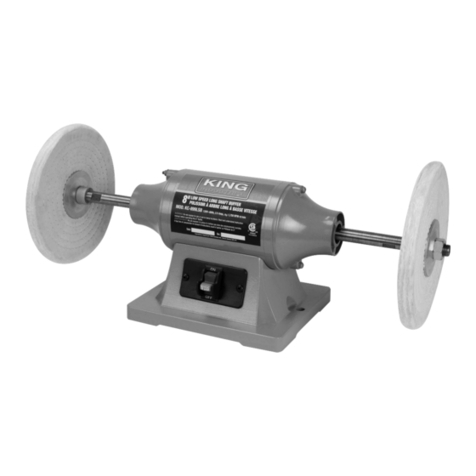
King Canada
King Canada King Industrial KC-899LSB instruction manual

Yost Vises
Yost Vises 908-HV manual
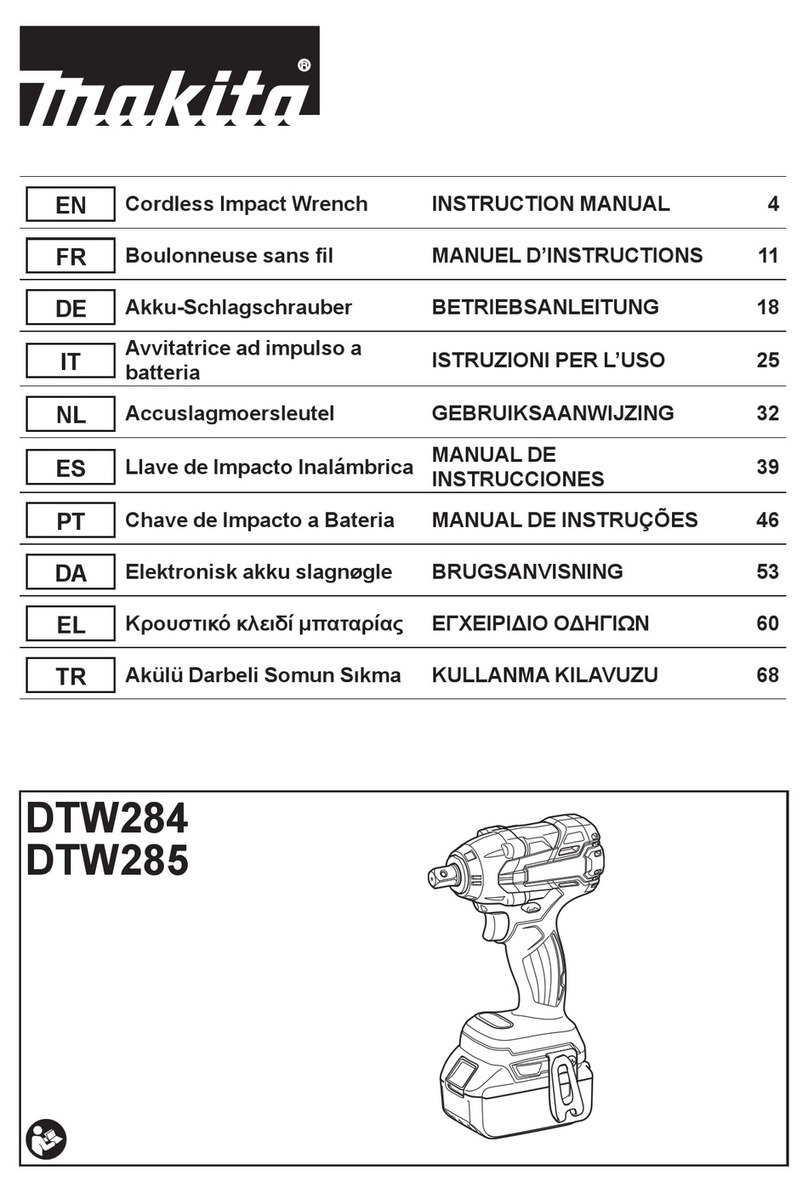
Makita
Makita DTW285RME instruction manual
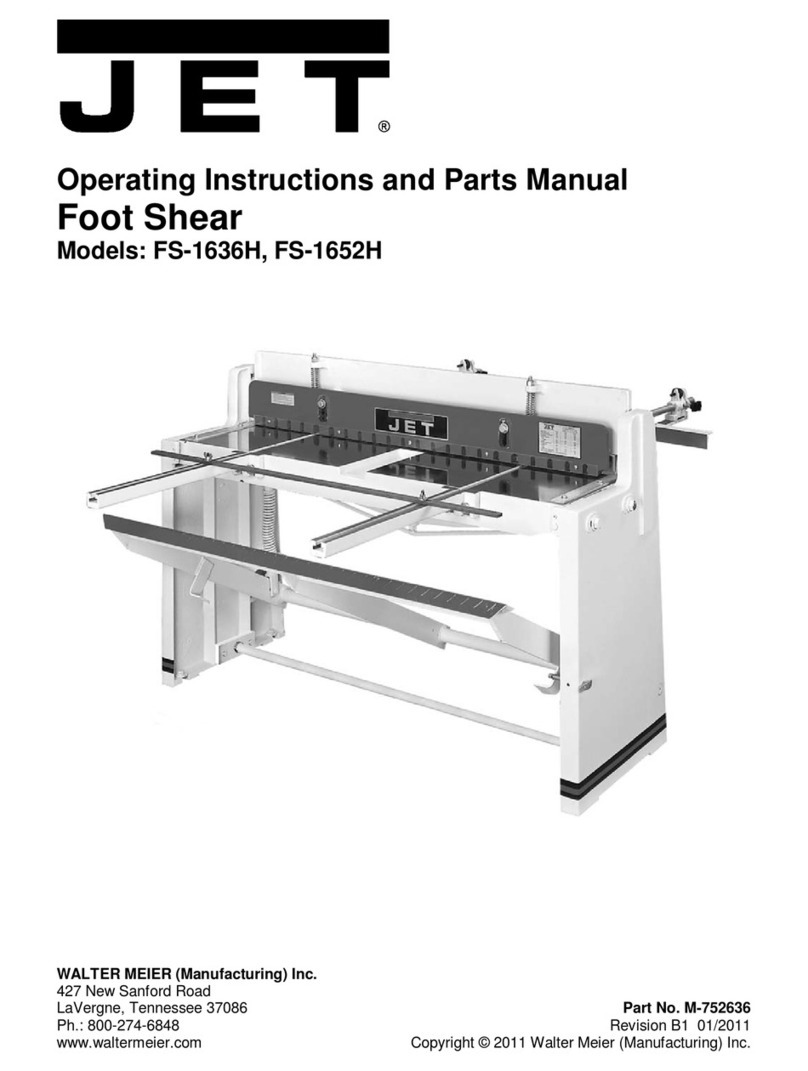
Jet
Jet FS-1636H Operating instructions and parts manual
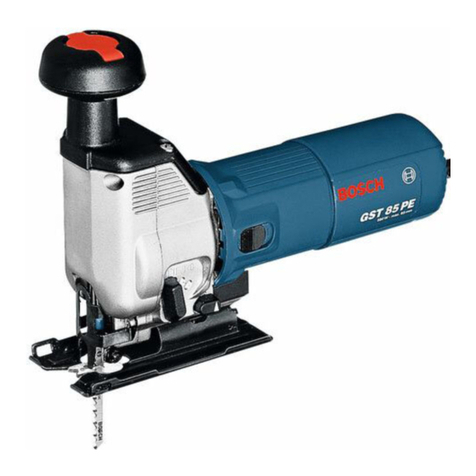
Bosch
Bosch GST 85 P Operator's manual
